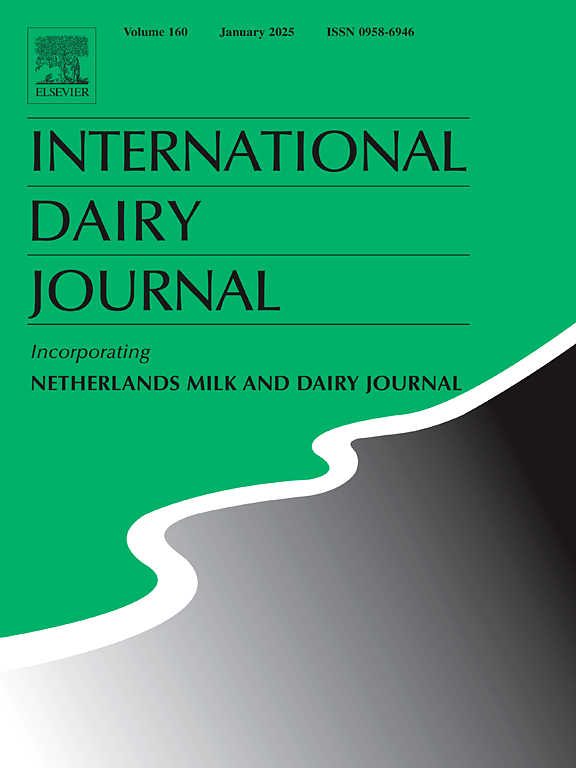乳中β-隐黄质包封纳米脂质体,通过强化提高维生素A的研究
IF 3.1
3区 农林科学
Q2 FOOD SCIENCE & TECHNOLOGY
引用次数: 0
摘要
维生素A缺乏症(VAD)可对不同人群的健康造成有害的生理影响,因此需要寻找替代解决方案来解决这一全球性问题。本研究研究了β-隐黄质(一种包被纳米脂质体的维生素a原类胡萝卜素)在强化牛奶中的稳定性,以及这种针对VAD的强化牛奶的理化性质。在强化之前,荧光光谱证实β-隐黄质被包封在纳米脂质体的疏水膜内,过氧化值为0.74±0.04 mEq/kg,表明其具有较强的氧化稳定性。在高达100 μg/mL的强化剂(β-隐黄质包封纳米脂质体)存在下,人胚胎肾细胞的细胞存活率高达90%。强化牛奶保留了其营养成分,包括脂肪、蛋白质、干沉淀物、比重和颜色(p >;0.05)。强化后,粘度略有增加(p >;0.05),电导率略有下降(p >;0.05),为4.55±0.05 ~ 4.41±0.03 mS/cm。此外,92%的β-隐黄质在热处理(63°C 30分钟,72°C 15秒,135°C 3秒)后被保留,证实了强化牛奶的耐热性。强化乳的铁还原能力显著提高,从196.02±0.16 μmol/L提高到548.57±1.23 μmol/L (p <;脂质过氧化从0.40±0.02 mg /L降至0.29±0.05 mg /L (p <;0.01)。蛋白质羰基浓度也降低(p <;0.01),从0.95±0.07到0.62±0.02 nmol/mg,保护牛奶蛋白不被氧化。在模拟条件下,约17%-48.32%的维生素A推荐膳食摄取量来自强化牛奶,解决了VAD的挑战。本文章由计算机程序翻译,如有差异,请以英文原文为准。

β-cryptoxanthin encapsulated nanoliposome in milk with an approach to enhance vitamin A through fortification
Vitamin A deficiency (VAD) can result in harmful physiological effects on health across diverse populations, highlighting the need for alternative solutions to address this global issue. This study investigates the stability of β-cryptoxanthin, a provitamin A carotenoid encapsulated in nanoliposomes, in fortified milk, along with the physicochemical properties of this fortified milk aimed to target VAD. Prior to fortification, fluorescence spectroscopy confirmed the encapsulation of β-cryptoxanthin within the hydrophobic membrane of the nanoliposome, with a peroxide value of 0.74 ± 0.04 mEq/kg, indicating its strong oxidative stability. Up to >90% cell viability of the Human embryonic kidney cells was observed in presence of up to 100 μg/mL of the fortificant (β-cryptoxanthin encapsulated nanoliposome). Fortified milk retained its nutritional composition, including fat, protein, dry sedimentation, specific gravity, and colour (p > 0.05). Following fortification, minor increase in viscosity (p > 0.05) and slight decrease in electrical conductivity (p > 0.05), from 4.55 ± 0.05 to 4.41 ± 0.03 mS/cm, was observed. Additionally, >92% of β-cryptoxanthin was retained after heat treatment (63 °C for 30 min, 72 °C for 15 s, and 135 °C for 3 s), confirming the thermostable nature of the fortified milk. The fortified milk showed a significant increase in ferric-reducing antioxidant capacity, from 196.02 ± 0.16 to 548.57 ± 1.23 μmol/L (p < 0.01), while lipid peroxidation decreased from 0.40 ± 0.02 to 0.29 ± 0.05 mg malondialdehyde/L (p < 0.01). Protein carbonyl concentration was also reduced (p < 0.01), from 0.95 ± 0.07 to 0.62 ± 0.02 nmol/mg, protecting milk proteins against oxidation. About 17%–48.32% of the recommended dietary allowance for vitamin A was obtained from fortified milk under simulated conditions, addressing VAD challenges.
求助全文
通过发布文献求助,成功后即可免费获取论文全文。
去求助
来源期刊

International Dairy Journal
工程技术-食品科技
CiteScore
6.50
自引率
9.70%
发文量
200
审稿时长
49 days
期刊介绍:
The International Dairy Journal publishes significant advancements in dairy science and technology in the form of research articles and critical reviews that are of relevance to the broader international dairy community. Within this scope, research on the science and technology of milk and dairy products and the nutritional and health aspects of dairy foods are included; the journal pays particular attention to applied research and its interface with the dairy industry.
The journal''s coverage includes the following, where directly applicable to dairy science and technology:
• Chemistry and physico-chemical properties of milk constituents
• Microbiology, food safety, enzymology, biotechnology
• Processing and engineering
• Emulsion science, food structure, and texture
• Raw material quality and effect on relevant products
• Flavour and off-flavour development
• Technological functionality and applications of dairy ingredients
• Sensory and consumer sciences
• Nutrition and substantiation of human health implications of milk components or dairy products
International Dairy Journal does not publish papers related to milk production, animal health and other aspects of on-farm milk production unless there is a clear relationship to dairy technology, human health or final product quality.
 求助内容:
求助内容: 应助结果提醒方式:
应助结果提醒方式:


